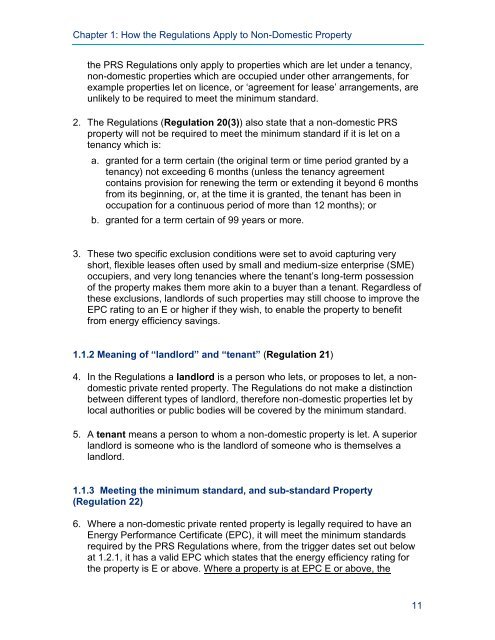THE NON-DOMESTIC PRIVATE RENTED PROPERTY MINIMUM STANDARD
Non-Dom_Private_Rented_Property_Minimum_Standard_-_Landlord_Guidance__2_
Non-Dom_Private_Rented_Property_Minimum_Standard_-_Landlord_Guidance__2_
Create successful ePaper yourself
Turn your PDF publications into a flip-book with our unique Google optimized e-Paper software.
Chapter 1: How the Regulations Apply to Non-Domestic Property<br />
the PRS Regulations only apply to properties which are let under a tenancy,<br />
non-domestic properties which are occupied under other arrangements, for<br />
example properties let on licence, or ‘agreement for lease’ arrangements, are<br />
unlikely to be required to meet the minimum standard.<br />
2. The Regulations (Regulation 20(3)) also state that a non-domestic PRS<br />
property will not be required to meet the minimum standard if it is let on a<br />
tenancy which is:<br />
a. granted for a term certain (the original term or time period granted by a<br />
tenancy) not exceeding 6 months (unless the tenancy agreement<br />
contains provision for renewing the term or extending it beyond 6 months<br />
from its beginning, or, at the time it is granted, the tenant has been in<br />
occupation for a continuous period of more than 12 months); or<br />
b. granted for a term certain of 99 years or more.<br />
3. These two specific exclusion conditions were set to avoid capturing very<br />
short, flexible leases often used by small and medium-size enterprise (SME)<br />
occupiers, and very long tenancies where the tenant’s long-term possession<br />
of the property makes them more akin to a buyer than a tenant. Regardless of<br />
these exclusions, landlords of such properties may still choose to improve the<br />
EPC rating to an E or higher if they wish, to enable the property to benefit<br />
from energy efficiency savings.<br />
1.1.2 Meaning of “landlord” and “tenant” (Regulation 21)<br />
4. In the Regulations a landlord is a person who lets, or proposes to let, a nondomestic<br />
private rented property. The Regulations do not make a distinction<br />
between different types of landlord, therefore non-domestic properties let by<br />
local authorities or public bodies will be covered by the minimum standard.<br />
5. A tenant means a person to whom a non-domestic property is let. A superior<br />
landlord is someone who is the landlord of someone who is themselves a<br />
landlord.<br />
1.1.3 Meeting the minimum standard, and sub-standard Property<br />
(Regulation 22)<br />
6. Where a non-domestic private rented property is legally required to have an<br />
Energy Performance Certificate (EPC), it will meet the minimum standards<br />
required by the PRS Regulations where, from the trigger dates set out below<br />
at 1.2.1, it has a valid EPC which states that the energy efficiency rating for<br />
the property is E or above. Where a property is at EPC E or above, the<br />
11


